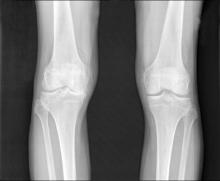ROME – Ensuring that intra-articular injections are correctly placed does not appear to result in better pain management for knee osteoarthritis, according to research presented at the European Congress of Rheumatology.
“Accurate injection neither resulted in higher rate of response to treatment than inaccurate injection nor greater mean pain reduction,” said George Hirsch, Ph.D., of the Institute of Inflammation and Repair at the University of Manchester (England) and the Dudley Group NHS Foundation Trust.
Dr. Hirsch and his associates defined response to treatment as at least a 40% reduction in pain on the Western Ontario and McMaster Universities Osteoarthritis Index (WOMAC), and the percentages who met that definition were similar among patients who had their injections correctly placed and those who did not at 3 weeks (57.7% vs. 63.4%, respectively; P = .0355) and 9 weeks (39.3% vs. 51.4%; P = .0148).
There also were no differences between mean pain reduction at 3 weeks (–110.7 mm vs. –116.9 mm on a visual analogue scale; P = .781) and 9 weeks (–65.2 mm vs. –92.8 mm; P = .247) between the patients with accurate and inaccurate intra-articular injection placement.
The researchers aimed to determine if injecting accurately into the knee could have an effect on patients’ pain outcomes because, despite the effectiveness of intra-articular corticosteroid injections (IACIs) for pain in knee OA, “responses to treatment vary.” In the poster presentation, Dr. Hirsch noted that uncertainty remained as to whether structural factors including accurate intra-articular placement mattered in regards to pain reduction.
The practical, prospective, observational study included 141 men and women with a mean age of 63.8 years who had been referred for IACI for their knee OA in a routine practice setting.
Before aspiration and injection into the affected knee(s) based on clinical examination, patients underwent careful x-ray and ultrasound assessment. Following injection, an air arthrosonogram was used to see if injections had entered the joint cavity.
Overall, just over half (53%) of patients were classed as responders at 3 weeks and 44% at 9 weeks, and a positive arthrosonogram was seen in 98 (70%).
In addition to no advantage for accurate injection placement on pain outcomes, there was no indication that individual physical factors mattered either. Mean measurements of sonographic effusion and synovial hypertrophy did not differ between responders and nonresponders at either time point assessed.
Similar findings also were seen for mean scores for power Doppler signal and individual radiographic features of osteoarthritis that included joint-space narrowing and presence of bone spurs.
“These results raise potential questions about the routine use of [ultrasound] to enhance or predict response to IACI in knee OA,” Dr. Hirsch said.
The authors reported having no financial disclosures.

